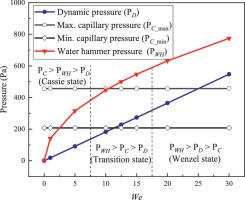International Journal of Multiphase Flow ( IF 3.6 ) Pub Date : 2021-02-24 , DOI: 10.1016/j.ijmultiphaseflow.2021.103611 Zhicheng Yuan , Mitsuhiro Matsumoto , Ryoichi Kurose

|
Surfaces with a wettability gradient, which require no external energy input, play a significant role in controlling and manipulating the self-transport of liquid drops. This work numerically investigates the directional rebound behavior of water droplets on surfaces with wettability gradients obtained by gradually altering the groove width. The results show that three types of droplet rebound behavior (vertical bouncing, following, or against the roughness gradient) and the rotating motion (counterclockwise), which are dominated by the combined effects of the unbalanced Young's force and the wetting state, are affected by the Weber number (We), groove width, and groove depth. Droplets remain in the Cassie state and rebound following the roughness gradient for a small We, small groove width, and larger groove depth. By contrast, when the Cassie and Wenzel states are both present, droplets are partially arrested by the ridges and grooves and rebound against the roughness gradient. Additionally, vertical rebounding behaviors are observed at extremely small owing to the low contact-angle hysteresis, and at critical because the Young's force and capillary emptying process are balanced. Therefore, both the unbalanced Young's force and wetting state should be considered when investigating the bounce behavior of droplets impinging surfaces with a roughness gradient. The results provide important insight into the design of wettability gradient surfaces for controlling droplet transport.
中文翻译:

液滴的定向回弹撞击具有粗糙度梯度的疏水表面
不需要外部能量输入的具有可湿性梯度的表面在控制和操纵液滴的自传输方面起着重要作用。这项工作以数值方式研究了水滴在表面上的定向回弹行为,该表面具有通过逐渐改变沟槽宽度而获得的可湿性梯度。结果表明,受不平衡杨氏力和润湿状态共同作用的三种类型的液滴回弹行为(垂直反弹,跟随或逆着粗糙度梯度)和旋转运动(逆时针)受以下因素影响:韦伯数(We),凹槽宽度和凹槽深度。水滴留在卡西的状态和反弹下面一个小粗糙度梯度我们,较小的凹槽宽度和较大的凹槽深度。相比之下,当同时存在Cassie和Wenzel状态时,液滴会被脊和凹槽部分阻止,并随粗糙度梯度反弹。此外,在极小的情况下观察到垂直回弹行为 由于低的接触角迟滞,并且处于临界状态 因为杨氏力和毛细血管排空过程是平衡的。因此,在调查以粗糙度梯度撞击表面的液滴的弹跳行为时,应同时考虑不平衡的杨氏力和润湿状态。该结果为控制液滴传输的润湿性梯度表面的设计提供了重要的见识。











































 京公网安备 11010802027423号
京公网安备 11010802027423号